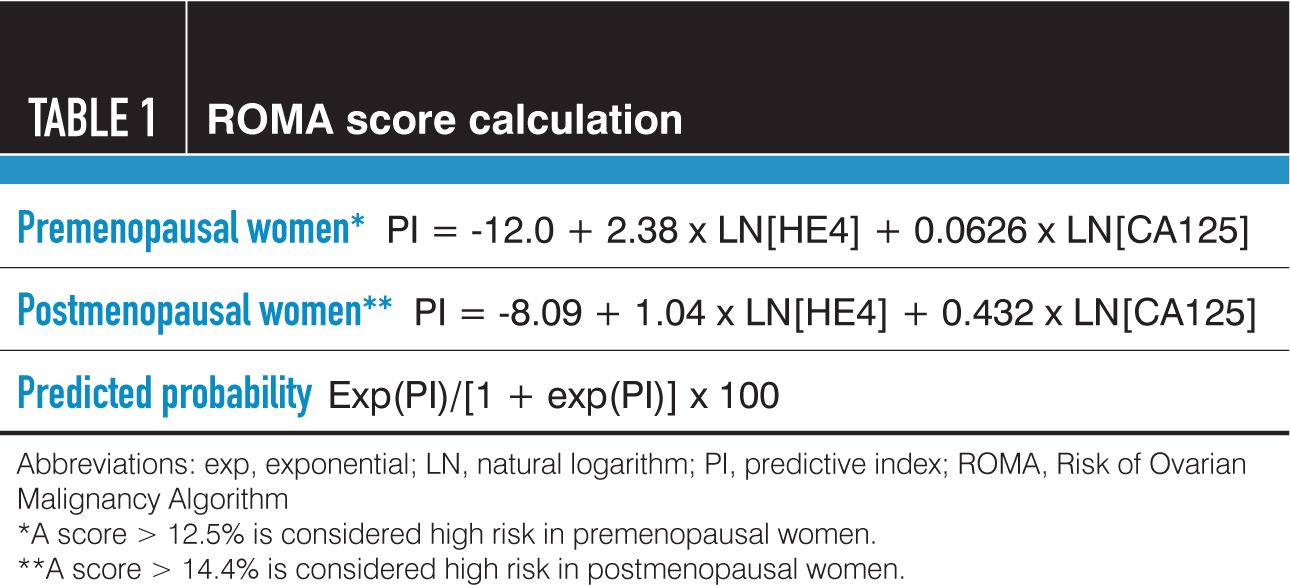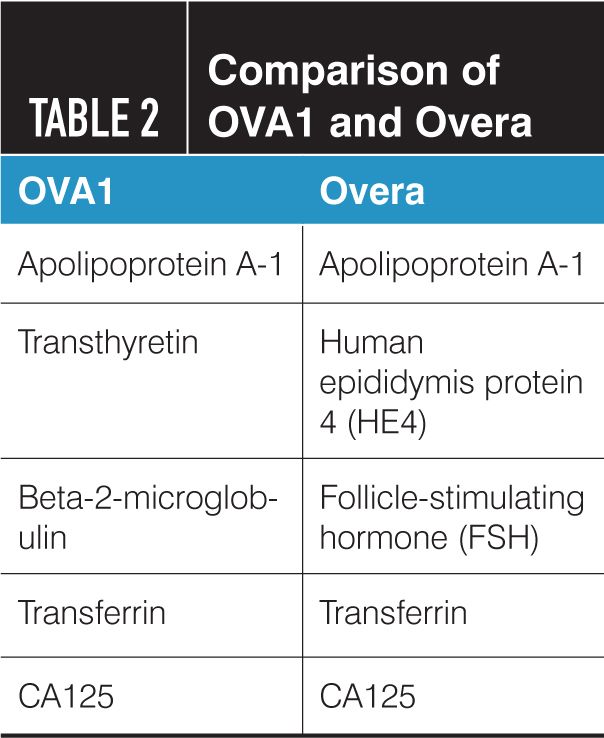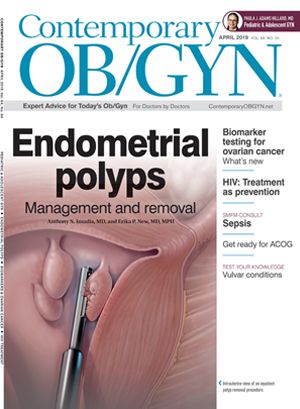What’s new in biomarker testing for ovarian cancer
Three tests are now FDA-approved for triaging pelvic masses in asymptomatic women.
©Medistock - stock.adobe.com

Table 1

Table 2

Management of an adnexal mass is a common clinical scenario for obstetricians, gynecologists, and other providers in women’s health. Masses may be identified upon routine annual examinations, incidentally during imaging for other conditions, or when women present with pelvic and/or abdominal symptomatology. Many masses are ultimately found to be benign at time of surgery. Others, however, are malignant, and appropriate preoperative referral to a gynecologic oncologist for surgical management, staging, and determination of potential adjuvant therapy is critical to the outcome in these patients.
Epithelial ovarian cancer remains an aggressive disease. The American Cancer Society estimates that in 2019, 22,530 women will be diagnosed with ovarian cancer and 13,980 of them will die, ranking this malignancy the fifth most lethal behind lung, breast, colon and pancreas.1 Unfortunately, fewer than half of all women with ovarian cancer are cared for by a gynecologic oncologist, despite data supporting improved outcomes when a specialist is managing their care.2,3 These findings underscore the importance of appropriate and early referral.
Determining which women with adnexal masses will ultimately have cancer at time of surgery remains a clinical challenge. To assist in this risk stratification, initial evaluation of women with a pelvic mass has typically included ultrasound imaging and serum biomarker testing. To best care for patients most at risk, the American College of Obstetricians and Gynecologists (ACOG) recommends referral to a gynecologic oncologist for women who have a pelvic mass combined with elevated serum CA125, ascites, and/or evidence of metastatic disease.4 For women who have a mass but no ascites or imaging suggestive of metastatic disease, the accuracy of biomarkers for identification of those at highest risk of cancer is crucial to determine whether they would benefit from specialty referral. This review updates our current knowledge of preoperative biomarker utilization to optimize outcomes for women with a pelvic mass.
CA125 testing
The serum biomarker CA125 has long been considered one of the primary evaluation tools in preoperative assessment of women with pelvic or adnexal masses. CA125 is a protein expressed in epithelial tissues, including the mesothelial lining of the pleura and peritoneum, and the Müllerian cells of the fallopian tube, endometrium, and endocervix.5
Surprisingly, CA125 is not typically expressed by the surface epithelium of benign ovaries. However, 90% of women with metastatic epithelial ovarian cancer have elevated serum levels, which has led to widespread adoption of this test in evaluation of potential malignancy. Unfortunately, the sensitivity and specificity of CA125 in predicting ovarian cancer remains low. Fifty percent of women with stage I ovarian cancers, where disease is confined to the ovaries, will have a normal preoperative CA125 level. In addition, several conditions will lead to serum elevations in CA125. These include both benign gynecologic processes, such as uterine fibroids, ovulation, menstruation, and endometriosis, and malignancies of other abdominal organs, such as gastric, colon, and pancreatic cancers.5 For these reasons, the US Food and Drug Administration (FDA) has not approved CA125 for preoperative use, but only for cancer surveillance after a diagnosis of ovarian cancer.
Novel biomarkers
Over recent decades, limitations in the ability of CA125 to detect ovarian cancer have led investigators to evaluate additional serum proteins as potential candidates for biomarker utility, given the relative ease and reliable reproducibility of serum testing. Several initial studies in the early 2000s suggested combinations of serum markers, in contrast to CA125 alone, as a diagnostic tool in women with adnexal masses. These include the OvaSure serum test, which incorporated serum levels of leptin, prolactin, osteopontin, insulin-like growth factor II, macrophage inhibitory factor, and CA125 into a diagnostic algorithm. The OvaCheck test similarly expanded this scale into proteomic profile analyses of thousands of serum proteins.6-8 Unfortunately, the lack of validation studies undermined the effectiveness of these modalities in clinical care.
HE4 and risk of malignancy algorithm
New data identified additional markers, which have led to development and validation of diagnostic tests in clinical care of women with a pelvic mass. Human epididymis protein 4, or HE4, is a protease inhibitor expressed by malignant epithelial ovarian cells that can be identified in the sera of women with ovarian cancer.9 In 2008, data on HE4 led to FDA approval of it as a monitoring tool for women who have a history of ovarian cancer.
Subsequent research examining HE4 in combination with CA125, in the context of menopausal status, led to development of a logistic regression model as a diagnostic tool in women with a pelvic mass. This Risk of Malignancy Algorithm (ROMA) classifies patients into high risk or low risk for ovarian cancer based upon a score, which is a predictive index calculated with equations that differ based on the patient’s menopausal status (Table 1). Calculators are available online that can generate the risk assessment based upon CA125 and HE4 assay results, along with menopausal status.
Validation studies that led to FDA approval of ROMA were detailed in a prior review in this journal.10 In brief, the initial prospective study in a high-risk population (women recruited after seeing a gynecologic oncologist) identified sensitivities of 92% and 76% (for postmenopausal and premenopausal women, respectively), with a specificity of 75%.11 A subsequent study in a low-risk population (women with an adnexal mass recruited into the study after seeing a gynecologist, family practitioner, internist, or general surgeon) reported sensitivities of 100% and 92% and specificities of 76% and 74% (in postmenopausal and premenopausal women, respectively).12 These data led to the 2011 FDA approval of ROMA to determine risk of ovarian cancer in women with a pelvic mass.
OVA1
In parallel studies, other investigators examined additional biomarkers in a multivariate index assay as a diagnostic tool in women with suspected ovarian malignancies. This assay, now known as OVA1, incorporates serum levels of five serum proteins (transthyretin, apolipoprotein A-1, b2-microglobulin, transferrin, and CA125) in a proprietary software calculation to generate a high or low probability for malignancy score (Table 2). As with ROMA, menopausal status affects interpretation of the score; 5.0 or higher is considered high probability of ovarian cancer in premenopausal women, whereas a score of 4.4 or higher is high probability in postmenopausal women.
Validation studies that led to FDA approval of OVA1 were detailed in a prior review in this journal.10 In brief, the sensitivity of OVA1 was found to be 100% for stages II, III, and IV ovarian cancer, and 90% for stage I ovarian cancer. The specificity in this cohort, however, was 43% for OVA1 alone, and 35% for OVA1 combined with physician assessment.13 The investigators of this study further evaluated their cohort in the context of the ACOG referral guidelines; when substituting OVA1 for CA125, they found improved sensitivity (94% with OVA1 versus 77% with CA125) but decreased specificity (35% versus 68%).14 These studies led to FDA approval of this assay in 2009 as a tool for use by a patient’s primary physician to decide whether a patient with an ovarian mass should be referred to a gynecologist or a gynecologic oncologist. It is not approved for use to screen or to determine whether a patient should proceed to surgery.
Overa
The relatively low specificity of OVA1 led to valid concerns by many obstetricians and gynecologists about a larger proportion of patients with benign disease being referred to specialists outside their practices. As such, additional biomarker breakthroughs have led to a second-generation OVA1 test. Initially known as OVA2, this novel assay is now trademarked as Overa. Overa replaces transthyretin and beta-2-microglobulin from OVA1 with HE4 and follicle-stimulating hormone (FSH) (Table 2). The goals of this new assay are to improve the specificity and positive predictive value (PPV) of OVA1 while maintaining high sensitivity and negative predictive value; in addition, inclusion of FSH abrogated the need for clinicians to determine menopausal status when interpreting the results. Overa stratifies patients with an adnexal mass into high- or low-risk categories based upon a scale of 0 to 10, and uses a single cutoff of 5. Clinical validity was determined using banked serum samples from a prospective cohort of 493 women undergoing surgery for an adnexal mass, with an observed cancer prevalence of 18.7%. The sensitivity of Overa remained high at 91%; combining Overa score with physician assessment demonstrated a sensitivity of 94%.15 Specificity of Overa was significantly higher at 69%, compared to 54% seen in the same cohort with OVA1. The PPV of Overa was also superior (40% versus 31%). Inclusion of Overa with physician assessment identified 75% of the malignancies missed by physician assessment alone. These data led to FDA approval in 2016 to market this second-generation assay in conjunction with independent clinical and imaging assessment prior to planned surgery for women with a pelvic mass.
Overa has been further examined in an independent cohort to assess the combination of a symptom index with this assay to predict risk of malignancy in a prospective cohort of 216 women with a documented adnexal mass planned for surgery. In this cohort where 64 patients (21%) were found to have epithelial ovarian or fallopian tube cancers, self-reported symptoms (pelvic and/or abdominal pain, increased abdominal size and/or bloating, and difficulty eating and/or feeling full) and Overa independently demonstrated high sensitivities (87% and 92%, respectively). However, the combination of both a positive symptom index and a positive Overa test led to a significant improvement in sensitivity (96%).16 Taken together, these data suggest that physician assessment, including evaluation of patient self-reported symptoms, combined with Overa are powerful and accurate tools to determine which patients are at highest risk of malignancy.
Conclusion
Advances in biomarker discovery have led to several FDA-approved tests superior to CA125 in preoperative evaluation of women with a pelvic mass. While OVA1 has higher sensitivity for determining malignancy than CA125, its decreased specificity may generate referrals of benign disease to gynecologic oncologists. Both Overa and ROMA have comparable higher sensitivities, and their improved specificities can more accurately determine which subgroups of patients would most benefit from consultation with a gynecologic oncologist. While none of these three tests can be or should be used for screening asymptomatic women with unremarkable imaging, Overa and ROMA represent the culmination of significant efforts that can improve risk stratification in women with a pelvic mass to triage their care to the appropriate provider.
Disclosures:
The author reports no potential conflicts of interest with regard to this article.
References:
- Siegel RL, Miller KD, Jemal A. Cancer Statistics, 2019. CA Cancer J Clin. 2019; 69:7-34.
- Mercado C. Zingmond D, Karlan BY, et al. Quality of care in advanced ovarian cancer: the importance of provider specialty. Gynecol Oncol. 2010: 117(1): 18-22.
- Minig L, Padilla-Iserte P, Zorrero C. The relevance of gynecologic oncologists to provide high-quality of care to women with gynecological cancer. Frontiers Oncology. 2016;5:1-6.
- American College of Obstetricians and Gynecologists. Practice Bulletin No 174: Evaluation and management of adnexal masses. Obstet Gynecol. 2016; 128(5): e210-226.
- Bast RC, Xu FJ, Yu HY, Barnhill S, Zhang Z, Mills GB. CA-125: the past and the future. Int J Biol Markers. 1998;13(4):179-187.
- Visintin I, Feng Z, Longton G, et al. Diagnostic markers for early detection of ovarian cancer. Clin Cancer Res. 2008;14(4):1065-1072.
- Mor G, Visintin I, Lai Y, et al. Serum protein markers for early detection of ovarian cancer. Proc Natl Acad Sci USA. 2005;102(21):7677-7682.
- Petricoin EF, Ardekani Am, HItt BA, et al. Use of proteomic patterns in serum to identify ovarian cancer. Lancet. 2002;359(9306):572-577.
- Hellstrom I, Raycraft J, Hayden-Ledbetter M, et al. The HE4 (WFDC2) protein is a biomarker for ovarian carcinoma. Cancer Res. 2003;63(13):3695-3700.
- 10. Li AJ. New biomarkers for ovarian cancer: OVA1 and ROMA in diagnosis. Contemp OBGYN. 2012;57:28-35.
- Moore RG, McMeekin Ds, Brown AK, et al. A novel multiple marker bioassay utilizing He4 and CA125 for the prediction of ovarian cancer in patients with a pelvic mass. Gynecol Oncol. 2009;112(1):40-46.
- Moore RG, Miller MC, Disilvestro P, et al. Evaluation of the diagnostic accuracy of the risk of ovarian malignancy algorithm in women with a pelvic mass. Obstet Gynecol. 2011;118(2 pt 1):280-288.
- Ueland FR, Desimone CP, Seamon LG, et al. Effectiveness of a multivariate index assay in the preoperative assessment of ovarian tumors. Obstet Gynecol. 2011;117(6):1289-1297.
- Ware Miller R, Smith A, DeSimone CP, et al. Performance of the American College of Obstetricians and Gynecologists’ ovarian tumor referral guidelines with a multivariate index assay. Obstet Gynecol. 2011;117(6):1298-1306.
- Coleman RL, Herzog TJ, Chan DW, et al. Validation of a second-generation multivariate index assay for malignancy risk of adnexal masses. Am J Obstet Gynecol. 2016;82:e1-e11.
- Urban RR, Pappas TC, Bullock RG, et al. Combined symptom index and second-generation multivariate biomarker test for prediction of ovarian cancer in patients with an adnexal mass. Gynecol Oncol. 2018;150:318-323.

